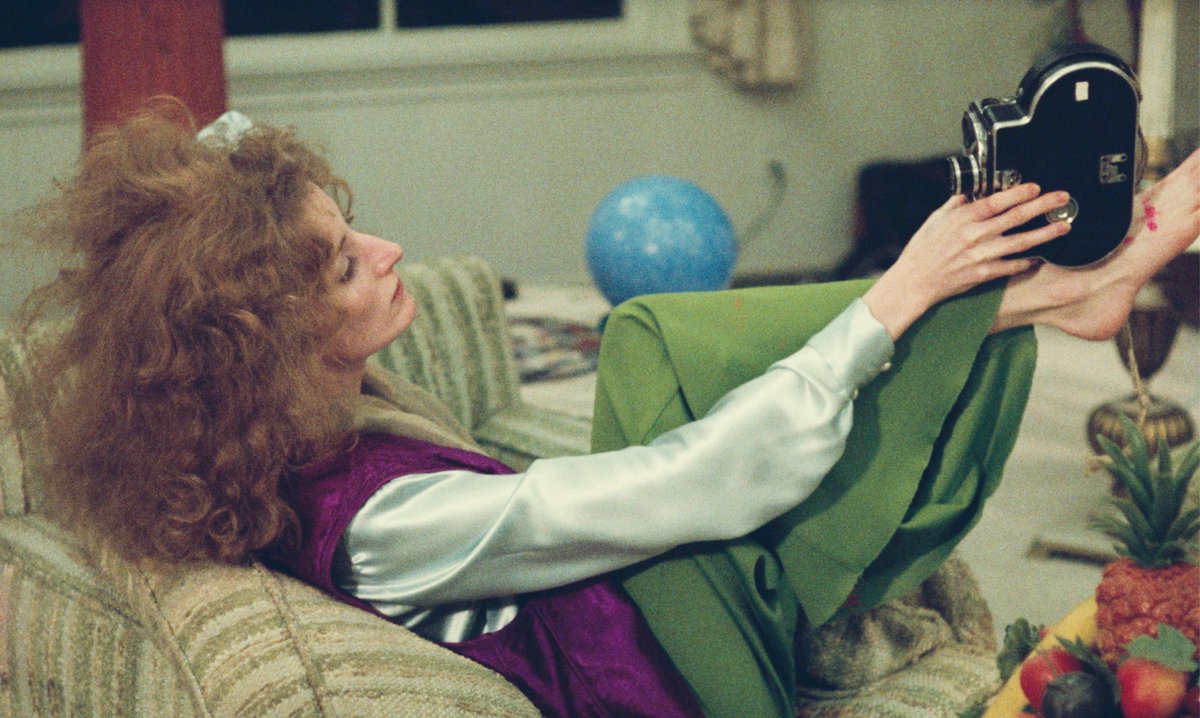
‘Viva was born Janet Susan Mary Hoffmann in Syracuse, New York, the daughter of Mary Alice (née McNicholas) and Wilfred Ernest Hoffmann. Hoffmann was the eldest of nine children born into a family of strict Roman Catholics. Her father was a prosperous attorney, and her parents were fervent supporters of the Army–McCarthy hearings held to expose Communist government infiltration. The Hoffmann children were required to watch the televised proceedings. Raised in devout Catholicism, she considered becoming a nun.
‘Viva began her career in entertainment as a model and painter. She retired from both professions however, claiming that she believed painting to be a dead medium, and describing her time as a model as, “…a period of my life I would rather forget.” She was given the name Viva by Andy Warhol before the release of her first film but later used her married last name (Auder). She appeared in several of Warhol’s films and was a frequent guest at The Factory.
‘Viva’s film career began in 1967, when she began filming Ciao! Manhattan, which was not completed until 1972. Viva approached Andy Warhol about being in one of his films, on the suggestion of her friend, Abigail. Warhol agreed, but only on the condition that Viva take off her blouse for the role. Viva responded by adhering bandaids to her breasts and visiting Andy at The Factory.
‘Viva appeared in many of Warhol’s films. The first, Tub Girls consists of Viva lying in a bathtub with various people of both sexes, including Brigid Berlin. She also appeared in Bike Boy, a film centered around a motorcyclist trying to find himself; and The Nude Restaurant, in which she played a waitress, opposite Taylor Mead.
‘By far, Viva’s most controversial role was in Blue Movie, a seminal film in the Golden Age of Porn that helped inaugurate the “porno chic” phenomenon in modern American culture. Viva played opposite Louis Waldon. The film consists of improvised dialogue between Viva and Waldon about a multitude of topics, including The Vietnam War, President Nixon, and various mundane tasks. These conversations are interrupted by the main event of the film, in which Viva and Waldon actually perform sexual acts in front of the camera. The film was seized by New York City Police for obscenity, and the theater manager, projectionist, and ticket-seller at the Warhol Garrick Theater arrested for possession of obscene materials.
‘Viva was on the phone with Andy Warhol when he was shot by Valerie Solanas in 1968. Following Solanas’ attempt on Warhol’s life, Viva developed a close, personal friendship with Warhol’s mother, Julia Warhola. Returning from the hospital, however, Andy accused Viva of utilizing his absence to spy on his work and his mother, creating a rift in a relationship that was never repaired. Viva never saw Mrs. Warhola again after that.
‘On November 1, 1968 Viva appeared on The Tonight Show on an evening that was guest-hosted by Woody Allen. Four years later Allen cast her in his 1972 film Play It Again, Sam in the roll of Jennifer. Viva’s first starring role in a non-Warhol film was in Agnes Varda’s Lions Love. The film features Viva in a ménage à trois with Gerome Ragni and James Rado.
‘After she began making films for other directors from Midnight Cowboy to Play It Again, Sam to Paris, Texas she also began writing. Her first book, Superstar, was an insider’s look at the Factory scene, a partly fictional autobiographical account of her time there. It was distinguished from other “tell-all” memoirs by virtue of her writing, which incorporated various stylistic effects, including the use of taped conversations. She also wrote for various publications, including The Village Voice and New York Woman.
‘Viva incorporated the use of video tapes into her second book The Baby. These tapes were later released by her former husband, video artist Michel Auder, as Chronicles: Family Diary in three parts.
‘She was the narrator for Carla Bley’s 1971 experimental jazz composition Escalator over the Hill. Viva was one of the early pioneers in Video art. During the 1970s Viva was a guest participant in Shirley Clarke’s Teepee Video Space Troupe, which she formed in the early 1970s.
‘Now 72, Viva lives in Palm Springs, where she continues to make art. Her last film was News from Nowhere (2010) directed by Paul Morrissey. She spends much of her time painting. An exhibition of her work was held in 2014 at The Thousand Islands Arts Center in Clayton, New York. She is also active on social media expressing her opinions in much the same way she did during the Warhol years.’ — collaged
____
Stills
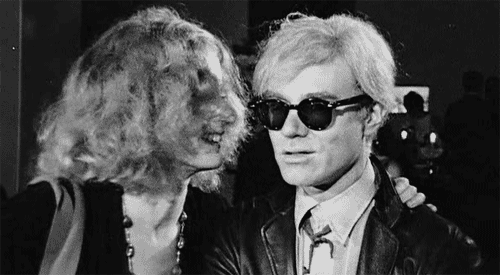



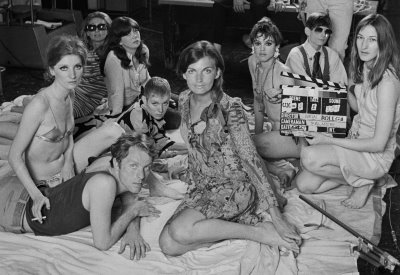

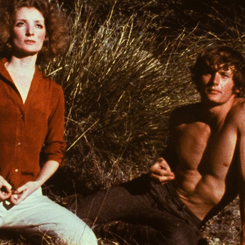
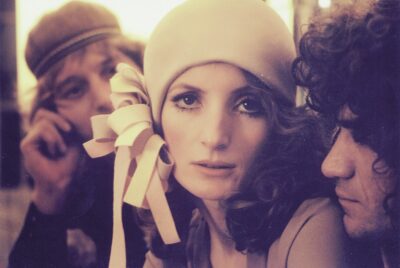



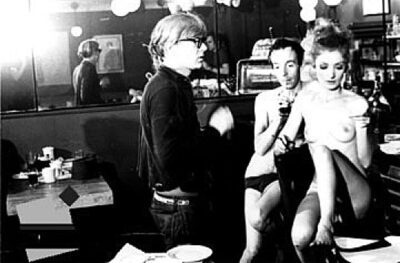







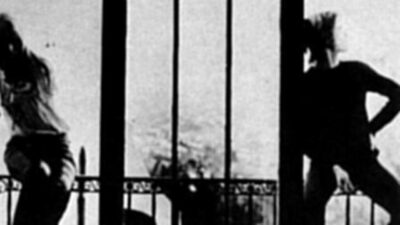







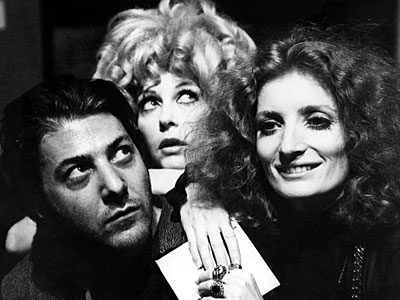
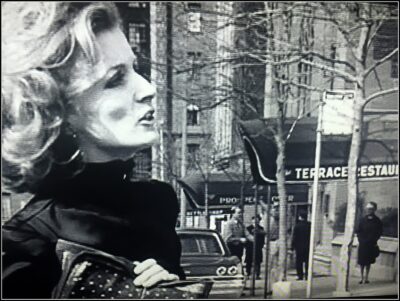
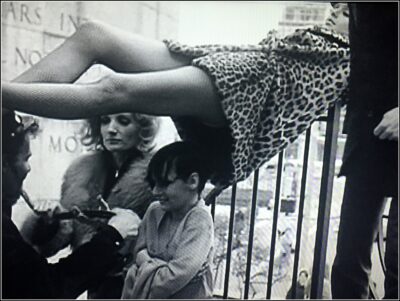
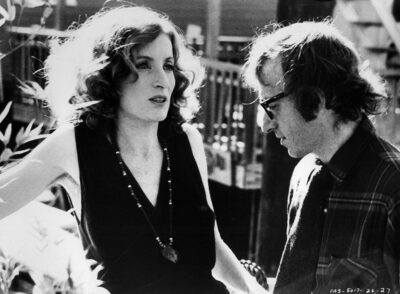
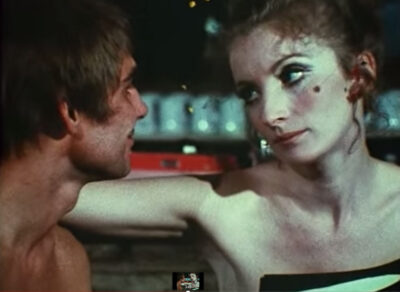

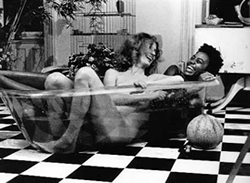


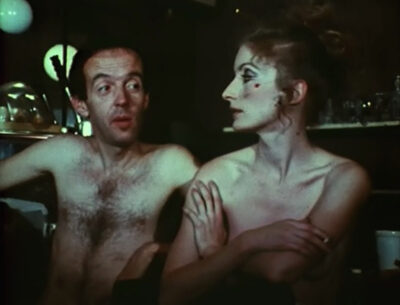




____
Further
Viva @ IMDb
Viva @ warholsuperstars.org
Book: Viva ‘Superstar’
My Dinner with Warhol Superstar Viva Hoffmann
Viva @ Revolver Gallery
Andy Warhol’s Superstar Viva: Where Is She Now?
Viva Remembers Andy, His Mother & The Artist’s Early Brush With Death
Viva objects to the screening of Blue Movie at the Whitney
Viva @ SoHo Memory Project
____
Extras
Viva speaks of her experience at The Factory with Andy Warhol.
Warhol and Superstar Viva
Nico and Viva interviews
_______
Interview (1975)
from Interview Magazine
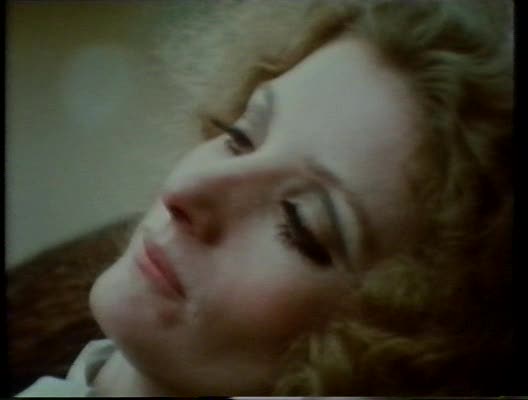
BOB: What’s your life like in California?
VIVA: We live in a mountain cabin with no central heating. While Michel [Michel Auder, Viva’s [then] husband] saws wood, i’m writing books for five hours a day. And then we take a drive to the coast to watch the whales migrate and the pelicans. So I’ve had a completely domestic life. A Virginia Woolf life. You seem to be getting bored already.
BOB: No. I’m just listening.
VIVA: And Virginia said to write good literature, you have to read good literature and take long walks. So I began writing at 9:30 in the morning with a bottle of Jack Daniels and when the tip of my tongue got numb around two, I quit. Michel took Alexandra [Viva’s child] to school and finished sawing wood for the fireplace. This is after living in a trailer with now windows, a 30s trailer, you know., that costs a million dollars today, full of inlaid wood, with Alexandra sleeping on a table…
BOB: But…
VIVA: … in the rain, in the mud, typing on a battery-operated typewriter, outside the trailer, in the mud – alright we finally got into a house. So I was living like Virginia Woolf, taking long walks through the mountains, reading Proust and writing. And going to bed at nine at night and getting up with the sun to watch the chicken hawk who landed on the telephone pole outside the bedroom window every single morning at the same time. And the mountains had all been burned in a fire so they were a beautiful golden color right out the bedroom window.
Alright I’ve come to New York and I’m surrounded by a field of phalluses – every man I’d ever been in love with ten years ago who couldn’t get it up and was too fat and alcoholic is now slimmed-down, thick-haired, brilliantly elegant, thin and incredibly virile. So I went through several days resisting a field of phalluses only to wind up in a car crash with John Chamberlain and Neil Williams. This is their fourth or fifth car crash in the last few years and John’s just gone back to sculpting crashed cars so I went to his loft to see about 40 crashed car sculptures and ended up in one. But since all the telephone companies have been bombed and I was sitting in the back and didn’t see it coming, I thought it was a bomb. It was a four-car collision and I had buried my head in my arms, instantly on impact, after the whiplash got me. So when he hit the taxi next to to us and the taxi hit the car next to it, I thought it was bomb #2, a chain-reaction. I was sure of certain death. But here I am, totally alive.
And then I discovered this Osaka Health Club, at 4 E. 46th St., above the Ginza Sushi Restaurant, and had a fantastic two-hour sauna, hot tub and what’s the massage called? That Japanese massage? Where they stand on you? A 25-year old Japanese girl kneels on your ass, kneads your buttocks, spreads her legs and gets you in between. And I kept saying, “Harder, harder, harder!” She stood on the table with her heels in my calves and her hands on the ceiling. I said, “I still think you can do it harder!” Well, two days later, I could hardly move. But then she said, “You need injection, injection!” So I went to my doctor, Gene Schwartz, who had just had a stroke, and was described to me as paralyzed, totally. I’d expected this dottering old man with a left arm completely screwed-up, but he was perfectly healthy, he didn’t look a day older and didn’t seem paralyzed at all. So he gave me an injection of antibiotics and cortisone and some empirin and codeine. Well, that treatment cured me. I tell you. I was on the verge of the worst cold imaginable – hacking, coughing, sneezing, sinuses clogged… now I’m perfect, right? (Viva coughs.) Almost perfect.
Because I had to go to this literary party that Barbara Seaman gave me. She wrote “Free and Female”. So I went to Barbara Seaman and told everyone they were seeing an artificial state of health. I was really on the verge of pneumonia but between the Osaka Health Club and Gene Schwartz, I was ambulatory. And they were wonderful, all of them. I’d expected Feminist Writers – oh dear, this is going to be dreadful. Well it was fantastic. They were the best women I had ever met. Jill Robinson was just incredible to me. Alix Kate Shulman was fabulous. Their husbands were fabulous. Everyone was great. They inundated me with praise, showered me with compliments and told me I’d written the Last Word on Motherhood.
So by this time I was really on a Surrealist dream and Suzanne McGany of the Book of the Month said, “If only you’d had the husband hooked on jelly-beans instead of heroin, we could have taken the book.” I said, “My God half the country’s on heroin! The Vietnamese Army’s on heroin!” She said, You’re ten years in advance.” I said. “Ten years in advance? I mean, the country’s been nodding out for the last 20 years!” And I called Michel and I said, “Well, they said jelly-beans.” He said, “Quick, change it to jelly-beans!” Well, it was too late. By this time Suzanne was crying. I’m back at the party, right, and it’s about one in the morning and I said, “Suzanne, don’t worry, I’m anesthetized to pain, after my years in the trailer, in the mud, and the no-heating and the burned-out trees. I’ve gone through such hell to write this book, that I feel no pain that the Book of the Month won’t take it.” But now they’re reconsidering it, probably thanks to Barbara Seaman. I hope so.
Having a baby was such a shock to my system, and I really wanted to write a book about that, about children and mothers and how the most important thing in the world is really how we bring up our children and you can’t start at the middle and work through to the end, you’ve really got to start at the beginning. Because for years I’ve been obsessed between my mother and the John Birch Society and my Marxist guerilla video-tape friends and so on – I’ve been obsessed with politics, but it finally came down to where I saw that if you don’t start with your new-born babies, you can’t change anything in the world. You’ve got to start at the beginning.
So Michel and I have been videotaping for four or five years, starting when I was pregnant with Alexandra. So we had these 400 tapes so I took them and Michel made stills for the novel. First I wrote the novel and then I found chapters where I knew there was a video-tape that went with it, even though it might have been a month or two off or a different country or something because I fictionalized the novel. You know, I changed countries and…
BOB: Did you ever refer to videos for dialogue?
VIVA: All the way through. Constantly referring to video.
BOB: So that’s why you called it a “Video Novel”?
VIVA: Right. And there’s 200 stills. 20 plates of video stills like eight or ten on a page with a caption under each one. I wanted to go back to the 19th Century with the idea of illustrations. It’s always intrigued me. The idea of writing a novel and everyone knows that a novel is really real except my mother who says, “I only read non-fiction.” So the idea intrigued me out of writing a novel and taking the real models for the novel and using their photographs in the book. So I used myself and Alexandra and Michel because I couldn’t use anyone else without getting “the pants sued off me” as my lawyer father would say. So I just used sections where I could have the three of us in it. And I have pictures of like me smashing up the kitchen in a fit, washing dishes at midnight in a pair of rubber gloves and nothing else. I have this scene where the mother finally takes on a lover because the husband hasn’t been fucking her in years. The minute he sees her pregnant, he’s turned off. So I have this terrific love scene in there and I found this tape that could correspond with that and put that in, where the lover is on either heroin or cocaine, we don’t know which, we just keep referring to it as “the white powder” and he sniffs it off his favorite book, “Philosophie Dans La Boudoir” by the Marquis de Sade. That’s my favorite page.
And I got totally involved with Marcel Proust the whole time I was writing so I did a sort of hommage a Proust in the third section of the book where I describe the husband’s French background – his family who’d worked with Pierre and Marie Curie on radium and I sort of do a take-off on Proust’s style when I described these turn-of-the-century Victorians and their radium laboratory and so on. And now I’m on to Flaubert.
BOB: What happened to your film career?
VIVA: Michel and I just sort of exhausted our resources and spend everything we made on the video-tapes and didn’t have much business sense. So by the time I started this book, I was completely drained financially, emotionally and mentally from going to Europe and making these films with the French. You know, you cast them, costume them, do the dialogue, put your money into them and end up with a hideous case of the flu and dysentery and…
BOB: Which movie? The Agnes Varda…
VIVA: The Agnes Varda movie was scripted. I flipped out on the Agnes Varda movie because she had me living on the set and I couldn’t get any sleep – the footsteps only stopped above my head for about four hours a night.
BOB: This is “Lion’s Love”, right? And you did “Cleopatra” with Michel after?
VIVA: Was that after “Lion’s Love”? Yeah. And that was never shown. We were sued for a million dollars after we’d put so much work into it. The producer sued. And then they made their own version of it and gave a sneak preview and then it sort of disappeared. I don’t even know where it is or if they’ve burned the negative or what. But we spent so much time on it. It was really rich – the locations were really beautiful. We shot in these old Roman gardens and at Cinecitta and we had Yugoslavian wrestlers.
Three of the women in that movie were dead within a year of either murder or suicide. Agnetta Frieburg, Barbara St. John and Andrea Feldman. Andrea was fantastic in the movie. Do you realize what a great actress she is? Andrea? She played my slave and she carried the whole thing out in real life. I had a terrible case of the flu, a temperature of 104 and dysentery. I was shitting blood. At that point. At the high point scene where Cleopatra is dying, I’d have to run to the toilet – this horrible hole in the wall in Cinecitta – and Andrea would follow me carrying my train as my slave and she would actually wipe my ass. Andrea. She was incredible. Fantastic.
OK, she’s dead, Agnetta’s dead, Barbara’s dead, so by the time this period was over, I was just bankrupt emotionally so I started writing and I got into Proust and Virginia Woolf.
BOB: You said on the talk show today that your baby Alexandra still breast feeds?
VIVA: No, No, not at all. She just tweaks my nipple to go to sleep which drives me crazy.
BOB: What did you do last night?
VIVA: I went to dinner at Luchow’s and then I went to Ron Ferry’s to look at his neon sculptures which were quite beautiful and I talked for several hours to Diane Von Furstenburg and then I dropped what’s-his-name – guy Burgos – off in a taxi and then I went home to my chaste little bed. To dream about my one true love.
BOB: Who’s on his way to India.
VIVA: I’m writing a new book now. On Malibu. I’m writing it from – I’m eliminating myself completely. My central character is a male hustler. Not a hustler but a guy who lives off women because he wasn’t able to find a job after enjoying two minutes of fame in the 60s. He was an actor and has a heart of a poet and is always reciting poetry and women won’t take him serious because they love his cock so much and his beautiful green eyes and his fabulous tanned body. He’s a male sex symbol and he wants to be treated as a whole man and no one will. And my inscription page says: “Madame Bovary c’est moi” – Flaubert. So I’m trying to project myself into the mind of a man who’s being used as a sex object. I’m writing in the third person and trying to go back in time rather than forward. I thought I went far enough into the future with Michel and now the only way to go is back.
BOB: Do think it’s harder to write in the third person?
VIVA: It’s harder to write in the first person because you have to be so careful. Of yourself. It seems easier because you’re writing directly from memory, from your own mind. But you read it over and think, “Is this corny? Is this…” You keep reading over and over and over, trying and trying and trying to make yourself more universal.
BOB: What about your poetry?
VIVA: My poetry I write in spurts.
BOB: Can you recite any of it from memory? The Diane Arbus poem?
VIVA: Oh, sure. I’ll give you a choice of what you want to hear. I have a Saint Lawrence River series, I have a marriage series. These are my latest ones in Iambic Pentameter. you really want to hear the Diane Arbus one? It’ll start a terrible scandal. I could read “Ode to a Husband”. Then there’s “Wife” and “Marriage”. I have “Reality Setting In” and I have…
BOB: Do “Wife”.
VIVA: Here’s a pretty good, biting one – “Authoress”:
They’ve rejected my last two chap-
ters and hate the subject of my book
They want to give me money, if only
I’ll learn to cook
Cut out the extra spices, double the
entree
Not enough mashed potatoes, not
even a toss in the hay
How about the hero, what does he
have to say?
What is his reputation, what hap-
pened on the quai?
Couldn’t take more than a week you
know, of working night and day
Of paying attention to problems, you
know what you want to say
The landlord is waiting silently, a
bird who circles quietly
The grocer no longer smiles at me,
can’t wait for another day
And at my desk I’m writing poetry,
while my mind is reeling hopelessly
And my anguise screaming out at
me, that you have gone away
Cut out the extra spices, double the
entree
If they knew I’m writing poetry,
they’d take my pen away
The carpet needs a cleaning, the
children are a mess
He’s having a nervous breakdown,
and wishes I’d confess
Can’t say I’m really sorry, can’t say I
won’t do it again
Can’t say say it was an aberration, or
even a mortal sin
Only have this one obsession, to find
the perfect verse
So my love will be congealed, in a
aspic rich and terse
In a soup no one can drink from, in a
jelly that never melts
In a frozen food compartment, to
benefit his health
In a frozen food compartment, to
benefit his health
Then I’ll finish my novel, then I’ll de-
scribe the terrain
Put words in every mouth, write
reams about the rain
Hire a carpet cleaner, shampoo all
the kids
Go on television, to tell it like it is.
Go on television, to tell it like it is.
Go on television, to tell it like it is.
I’m still looking for Diane. Lately Iambic Pentameter had been slamming itself into my brain… alright, this is “Elegy for the Late Diane Arbus”:
Your body is pink and lovely, a white
unopened egg
You stand there so unguarded,
naked with unshaved leg
No don’t put on your clothes dear,
you’re so relaxed this way
I’m only shooting a head dear, that’s
what they told me to say
Yes please roll up your eyes dear, yes
do it again that way
You look just like you’re dreaming,
that’s what they told me to say
Don’t worry about your ribs dear,
keep the blanket out of the way
I’m only shooting your head dear,
that’s what they told me to say
When I saw the photo spread, in New
York magazine
When I saw what you did to me, I
wept and howled and keened
You who are older and wiser, whose
eyes were brown and deep
No pimp of hustler or gigolo, but a
woman who could weep
So I wasn’t shocked in the least dear,
nor did I shed a tear
When they found your body, your
bathtub as your bier.
Everyone will hate me for it. Because Diane’s been sainted.
BOB: Did you know her well?
VIVA: Not terribly well. I used to pose at Parson’s School of Design for the fashion illustrators. And she was teaching there and that’s where I met her. She knew everybody I knew.
BOB: She really made people look awful.
VIVA: Those photographs of me would probably be great in 20 years. When I saw the close-up at the Museum of Modern Art it looked really good.
Waiting for the telephone, to ring
me a reprieve
Get me out of washing dishes,
cleaning up the sieve
I know I’ve pronounced “sieve” wrong but…
Take me from this prison, these
walls I made for myself
Baking every brick with care, mak-
ing sure to keep me there
Adding with each day, another pile
of underwear
And when I was a hooker, when I
lived for randy men
When I dined in fancy restaurants,
when I screwed in walnut dens
Can’t believe I envied the wives that
were betrayed
Can’t believe I wanted to be some-
body else’s slave
Can’t believe I worried that my body
was my purse
Didn’t know in time I’d find my mind
my only curse.
______________
19 of Viva’s 26 roles
_______________
Andy Warhol Bike Boy (1967)
‘Bike Boy features Viva in her first acting role to reach an audience. (The Loves of Ondine was shot earlier, but premiered later.) With her bony, patrician profile, sly wit, and languid sophistication, Viva plays a character that one could almost call new: a politically engaged masochist. There are precedents for this figure – Frances Dee exclaims with an almost bug-eyed enthusiasm, “People you know are guilty of everything!” to her bail bondsman boyfriend in Rowland Brown’s Blood Money; Claire Trevor, a nice girl with a secret, finds herself attracted to pretty, sociopathic Lawrence Tierney in Robert Wise’s Born to Kill – but in a sense Viva takes her role much further without even leaving the couch. Viva is forthright in her intentions: “Every once in a while I like to go out and pick up a man. It alleviates the boredom.” She asks about Hell’s Angels’ gang bangs, and when Joe pleads ignorance, she asks incredulously, “They never confessed to you the intimate details of their sexual lives?” Somehow Viva’s charm and physical beauty blind Joe to the fact that he is being mocked far more thoroughly than he was at the hands of Brigid Berlin. Viva challenges him to fuck her on a motorcycle going 60 miles per hour; the prospect of sex with Viva pleases him so much that he goes along with the joke. Viva gives Joe kissing lessons, and later they undress. When at last they are both naked, Viva lies on the couch like a foreshortened Rokeby Venus, and Joe stands over her exposing his muscular backside to the camera. There is no reverse shot. The audience does not get to see what Viva sees – Joe’s penis – but members of the film crew can’t resist taking a peak. A few times, a door in the background of the shot opens briefly and shuts again. Aside from the briefest of flashes during the shower sequence, there is no cock in this film, nor is there any sexual intercourse. The consummation achieved in Warhol’s final work as a director, Blue Movie, does not occur. The film runs out before Joe and Viva get a chance to do more than kiss.’ — Amber Waves of Brain
Excerpt
________________
Andy Warhol The Nude Restaurant (1967)
‘At a New York City restaurant, the patrons are men, nude but for a G-string, waited on by one woman, also clad in a G-string (played by Viva) and a G-bestringed (bestrung?) waiter. While one is immediately hooked with the Persona style first take, the cut to the last scene is nothing short of incredible in the way it sharply turns and recasts all the questions (ethical, political – Mead vs “Burroughs”, aesthetic) that one asks of it; redeems a movie which can sometimes be a bit too cute (those jump cuts, Viva with her endlessly fertile and fascinating storytelling that crowds out any thought) for its own good. Of course it’s also hard to peel one’s eyes off the screen when that sublime weirdo Taylor Mead is fidgeting all over it.’ — Karthik
Excerpt
Excerpt
Excerpt
_______________
Andy Warhol **** (1967)
‘**** (Four Stars) was a twenty five hour movie made up of shorter film segments. It consists of 83 reels each lasting approximately 33 minutes. (CB) The reason that four stars were used as the title was because film critics gave the best films four stars in their reviews. Victor Bockris incorrectly referred to the film as 24 Hour Movie in The Life and Death of Andy Warhol whereas Warhol, himself, described it as his “twenty five hour movie” in Popism. According to Popism, the full version was only shown once. According to the Jonas Mekas filmography, the full version of **** (Four Stars) was shown on December 15-16, 1967 at the New Cinema Playhouse in New York. Mekas gives the address of the New Cinema as 125 West 41st Street but the handbill for the cinema, reproduced above, lists the address as 120 West 42nd Street. Note also that the handbill says “continuous showings from 1 p.m.” According to David Bourdon, the full-length version began at 8:30 pm on the 15th and continued until 9:30 pm on the 16th.’ — warholstars.org
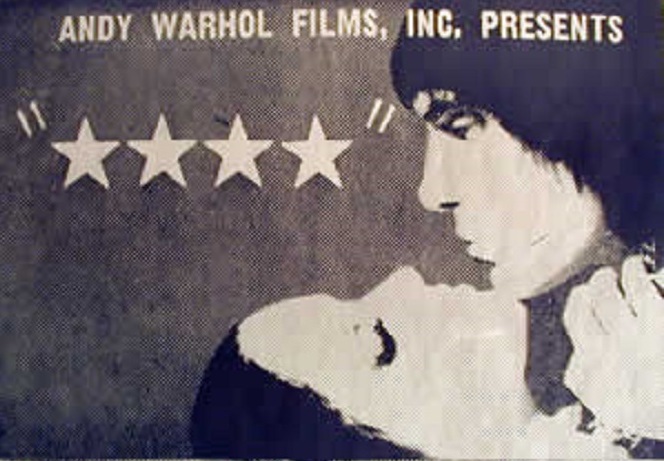
_______________
Andy Warhol The Loves of Ondine (1968)
‘Ondine is a gay man attempting to re-adjust his sexuality via various encounters with different women. After trying his luck with three women, Ondine becomes a background character in a sequence in which a group of Latin American men, calling themselves The Bananas, engage in a food fight. Ondine then engages in a wrestling match with Joe Dallesandro, who is married to Brigid Berlin.’ — letterboxd
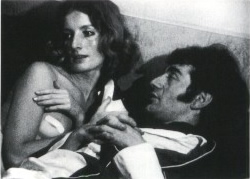
_________________
Andy Warhol, Paul Morrissey Lonesome Cowboys (1968)
‘Warhol’s group drove directly from Old Tucson to the Tucson Press Club, where Morrissey and Viva fielded most of the questions at a cocktail conference. “This is our two-hundredth film without a script,” Morrissey said. “Oh, there’s never a script,” Viva added. “we write it afterward from the sound track… Men seem to have trouble doing these nonscript things. It’s a natural for women and fags – they ramble on. But straight men can’t.” Our movies are not experimental as films,” Morrissey said, “but experimental as drama. There’s a minimum of dramatic interest, but they are still interesting because of the content of the dialogue. They are very primitive as films but revolutionary as drama.” A journalist asked when the film would be released. Morrissey answered, “As soon as it comes back from the drugstore.”‘ — David Bourdon
Trailer
Excerpt (dubbed into Italian)
_________________
Andy Warhol, Paul Morrissey San Diego Surf (1968)
‘In 1968, Andy Warhol directed the “San Diego Surf” movie. The 90-minute film was shot in La Jolla, California, and features Joe Dallesandro, Viva and Taylor Mead in a colorful and hilarious pop artwork. The surf movie by Andy Warhol was finished, but never hit the box office until 1995, when the Warhol Museum commissioned co-direct Paul Morrissey to finish it. In 2011, “San Diego Surf” saw the light of day at a special screening event. History books say the police were “all over” Warhol and his entourage of actors and actresses. The filming of “San Diego Surf” took two weeks, and it was a complete artistic circus with drinks, drugs and craziness. Viva, a Warhol superstar, went mad when she thought that Michael Boosin and Eric Emerson had put mescaline in her drink. It seems they didn’t do it, but she kept furious for several days. “San Diego Surf” tells the story of a married couple that has rented an extra beach house to a group of surfers sent by a Mr. Morrissey of La Jolla Realty. Ingrid Superstar, playing the daughter of Taylor and Viva, is pregnant and looking for a husband.’ — Surfer Today
Trailer
________________
John Schlesinger Midnight Cowboy (1969)
‘Rizzo and Buck are talking in a diner when a strange duo enter, snap Buck’s picture and hand him a flyer to a mysterious party, located “at Broadway and Harmony Lane,” another false address designed for the film. Rizzo is incredulous and possibly jealous. “Where does it tell you to go? Klein’s bargain basement?” This is a reference the famous discount clothier S. Klein, and in particular to their location off Union Square. They eventually go to the strange party — or should I say ‘happening’ — of Hansel and Gretel Mac Albertson. “Flesh and blood and smoke will be served after midnight,” according to the flyer. The party style and decor is heavily influenced by Andy Warhol’s own psychedelic events, and there’s a glimmer of The Electric Circus in the set design. If that wasn’t enough, Warhol acolytes Viva, Ondine and Ultra Violet make brief appearances.’ — The Bowery Boys
Excerpt
_________________
Agnès Varda Lions Love (… and Lies) (1969)
‘Agnès Varda brings New York counterculture to Los Angeles. In a rented house in the sun-soaked Hollywood Hills, a woman and two men—Viva, of Warhol Factory fame, and James Rado and Gerome Ragni, who created and starred in the rock musical Hair—delight in one another’s bodies while musing on love, stardom, and politics. They are soon joined by underground director Shirley Clarke, playing herself as well as functioning as a surrogate for Varda. Lions Love (. . . and Lies) is a metacinematic inquiry into the alternating currents of whimsy and tragedy that typified late-sixties America.’ — Criterion Collection
Trailer 1
Trailer 2
Excerpt
_________________
John Broderick Sam’s Song (1969)
‘Awkward, dorky and uncomfortable like only a 70’s film can be. The theme is complications with love and sex in the free-wheeling 70’s. All id and no introspection. Many things are hinted at, but go nowhere. No one really seems connected to anyone else. Robert de Niro (who I didn’t recognize) plays Sam, who has all the seductive charm of your average acne-ridden 13 year old boy. But scores anyway! Ah, the 70’s. Somewhat shocking ending, but I found it hard to care much. None of the characters is particularly compelling.’ — kerriganm
Trailer
_________________
Michel Auder Cleopatra (1970)
‘Cleopatra situates itself in the same relationship to Hollywood as the Warhol/ Morrisey films of the period. It corresponds to Joseph Mankiewicz’s 1963 Cleopatra, starring Elizabeth Taylor and Richard Burton which Auder’s cast watched and used as the starting point for scene by scene improvisation Auder drew his cast from Warhol’s ensemble – including not only Viva and Louis Waldon, but also Taylor Mead, Ondine, Andrea Feldman, Gerard Melanga and others. The film revels in epic excess like Mankiewicz’s cinematic debacle which succumbed to vast length, a bloted budget, multiple revisions and a scandal occasioned by the extramarital escapades of its co-stars. In Auder’s Cleopatra, Viva is the queen, shrieking with an authority different from the languorous speech patterns she had perfected in Warhol’s films. The (newly invented) snowmobile substitutes for horses; the industrial setting of a factory becomes a showplace of armaments, and the whole Egypt section takes place in upstate New York. The streets and parks of Rome, where Waldon lived at the time, are the staging ground for his role as Caesar. In a wonderful display of Waldon’s charm and skills as an improviser, he begins a dialogue with local police who are then conscripted into the film as Roman soldiers. Auder shot the culminating orgy and gladiator scenes in the famous Cinécita film studio in Rome where Mankiewicz filmed. Due to a fight with his producers, Auder never edited the film which was lost for many years. It survives as an uncut degraded copy of the original.’ — collaged

__________________
Bill L. Norton Cisco Pike (1972)
‘”Cisco Pike” is a long way from being a masterpiece, but it has a nice hang-loose texture to it, and a group of good performances. The movie has been written off in some quarters as another youth-drug-music trip, which is too bad. It’s too bad all the other drug movies have made the Best Pal’s Overdose into a cliche; in “Cisco Pike,” worked into a freaky scene with Viva and Joy Bang, it might have worked. Viva is, of course, the Warhol superstar, seen here several months pregnant and in a mannered, amusing performance. She talks as if she is backing into a wry sentence sideways, and her speech patterns are funny like Mae West’s. Viva is the most interesting female performance in the movie, despite the presence of Karen Black, because Viva is new and we have seen the Black characterization before in “Five Easy Pieces.”‘ — Roger Ebert
Trailer
the entire film
__________________
Herbert Ross Play It Again, Sam (1972)
‘Basically a series of horror date tales, with Woody Allen striking out in ever more humiliating ways, the show hits its stride when Woody interacts with the spirit of Humphrey Bogart, imitated fairly accurately by Jerry Lacy. Bogart’s exhortations for Allan to grab and kiss women, to show them who’s boss, of course backfire miserably. Totally pathetic when using his own persona, Allen as Allan resorts to a constant flow of slapstick and pratfalls to keep the level of comedy up. Some of these are hilarious, like the way Allan mangages to toss record albums across the room and stumble over his own furniture. An interesting selection of actresses play the other women in Allan’s life. Susan Anspach as his estranged wife is practically supportive in her utter rejection, and going back is never an option. Jennifer Salt (Sisters) can’t believe her date isn’t a total nutcase. Warhol actress Viva plays a nymphomaniac, and Joy Bang a thrillseeking girl who gets carried off by bikers in mid-date.’ — DVD Talk
Excerpt
________________
David Wiseman Ciao! Manhattan (1972)
‘Directors John Palmer and David Weisman were among a group in the outer circle of Warhol’s Factory clique who began shooting a documentary on the NYC party scene around the adventures of Edie and hustler Paul America but never finished it, their budget evaporating and their cast out of control. America disappeared halfway through filming, only to be discovered in jail upstate on a pot bust. Edie accidentally burned down part of the Chelsea Hotel. The New York scene dried up and Palmer and Weisman were left with tons of great footage but no movie to speak of. Three years later, the directors caught up with Edie in California, where she was living after several hospitalizations and adventures with the Hell’s Angels, and they began filming again, constructing an elaborate framing device which incorporated the earlier footage as a series of dreamlike flashbacks. The result is strange and tragic, beautiful and hideous.’ — Pop Matters
Trailer
______________
Pierre Clementi New Old (1979)
‘New Old is a French film directed by Pierre Clémenti, co-starring himself as Warhol superstar Viva, released in 1979. It is the second part of an experimental trilogy comprising ‘Visa De Censure No.X’, ‘Livre De Famille’ and ‘Anima Mundi’. The Village Voice wrote, “Clémenti’s New Old (1979—subtitled Chronicles of the Present Times) flows together footage from more than a decade of his wandering between scenes, sets, and drugs, an accelerated world tour through various iterations of the “counterculture.” There are fragments of Clémenti on film and stage, a pilgrimage to Warhol’s New York and scrambled jamming . . . until the soundtrack tightens up guttural punk guitars from Les Lou’s”.’ — Wikipedia
Excerpt

_______________
Richard Elfman Forbidden Zone (1980)
‘A vibrant, bizarre hybrid of sci-fi and fantasy with avant-garde, jazz-inflected music by the composer, Forbidden Zone still remains unique decades after its inception. Suburbanites venture into a “Sixth Dimension” where, in addition to Lucifer, they encounter the domain’s diminutive king (Fantasy Island’s Tattoo, Hervé Villechaize), his domineering queen (Cry-Baby’s Susan Tyrrell) and an exiled monarch (Warhol superstar Viva). An anthropomorphic frog servant assists the royal couple; nightmarish Busby Berkeley–like dance sequences pop up out of nowhere. It’s even weirder than it sounds.’ — Rolling Stone
the entire film
_______________
Wim Wenders The State of Things (1982)
‘The State of Things, one of Wenders’ deceptively simple works, can now be viewed increasingly as one of Wenders’ great examinations of the difficulties of sustaining friendship and love, the contradictory need for dreams at the expense of stability, the nature of exile and the way nostalgia hinders one’s reading of the past. Without clearing his head with The State of Things, one doubts whether Wenders would have been able to make Paris, Texas (1984) and Wings of Desire/Der Himmel über Berlin (1987) with such precision and focus. Like Wenders, the protagonist, Friedrich Munro (Patrick Bauchau), is a self-aware director of European art films, who has established a tentative beachhead in Hollywood. The film-within-a-film that opens The State of Things, “The Survivors”, inspired by Allan Dwan’s The Most Dangerous Man Alive (1958), is being shot with independent funds just outside Lisbon. At a crucial point in shooting, the cinematographer (Samuel Fuller) tells Friedrich they have run out of film and the shadowy producers in the US are putting the film on hold until completion funds can be raised. For a few melancholy days the cast and crew, like school children on a “snow day”, make the most of things, in an almost empty hotel by the sea. The tensions between Friedrich and his actress wife (Viva Auder) are kept at bay by the good cheer of their young daughters. The actors drink, eat and flirt with each other. Friedrich’s scenarist (a cameo by co-screenwriter, Robert Kramer, who achieved mythic status in the underground with Ice in the late 1960s) muses on the nature of film and narrative. Fuller’s cinematographer leaves early because of a family illness. This mid-section, with its superficial air of improvisation, is a pitch-perfect encapsulation of people trying to gain both respite and critical distance from the bread and butter decisions that shape lives in the long run.’ — Senses of Cinema
Trailer
__________________
Wim Wenders Paris, Texas (1984)
‘Seemingly birthed from the dust that surrounds him, a man wordlessly emerges from the desert trudging towards an invisible horizon, his face is weary and withered, his memory elusive, haunted by deep regret and intense sorrow. Wim Wenders’ Paris, Texas is a melancholic and emotionally-compelling portrait of a broken man yearning for reconnection with a family whom he had left years ago. But much more so, the film is a reflection of America’s emotional fabric as seen through Travis’ strong sense of anachronism that’s coupled with images of run-down motels, visages of vast desert landscapes, and other pieces of American iconography. Paris, Texas, whose very title suggests a melding of European realism and American idealism, is a perceptive elegy of love and loss, eloquently set against the foreboding backdrop of middle America. It’s a beautiful yet devastating piece of filmmaking that offers powerful and astute insights into the processes of self-realisation, forgiveness and the act of moving on.’ — Ethan
Trailer
___________________
Mel Gibson The Man Without a Face (1993)
‘Mel Gibson as Justin McLeod, Nick Stahl as Charles E. ‘Chuck’ Norstadt, Robert DeDiemar Jr as Charles E. ‘Chuck’ Norstadt (grown up), Margaret Whitton as Catherine Palin, Fay Masterson as Gloria Norstadt, Gaby Hoffmann as Megan Norstadt, Geoffrey Lewis as Chief Wayne Stark, Richard Masur as Prof. Carl Hartley, Michael DeLuise as Douglas Hall, Gloria’s boyfriend, Ethan Phillips as Todd Lansing, George Martin as Sam the Barber, Jean De Baer as Mrs. Lansing, Jack De Mave as Mr. Cooper, Viva as Mrs. Cooper, Justin Kanew as Rob Lansing.’
Trailer
__________________
Michel Auder The Feature (2008)
‘If you had shot homemade footage obsessively for the last 40 years, perhaps your movie would be as exciting or as beautiful as that of artist and filmmaker Michel Auder’s. Then again, maybe not. Auder is the former husband of both “superstar” actress Viva of the Factory and photographer Cindy Sherman, which itself promises some memorable footage. With co-director Andrew Neel, he’s selected choice moments from the 5,000 hours of archival footage in order to create The Feature, a three-hour homage to his life—some of it fact, some of it fiction. Auder probably doesn’t know the difference. Narrating his life with his heavily French-accented English, Auder guides us through frolicking beach scenes, orgiastic sexual pursuits, and drug-fueled nights.’ — Interview Magazine
Trailer
*
p.s. Hey. ** jay, Hey. Great, happy to hear that the post contained things that spoke to you. ‘I do think they’re about as close as an encyclopedic work of fiction has come to being palatable to mainstream audiences, in terms of how much of it you have to engage with’: such a great way to put it. Yeah, I remember. I need to find a way to play another one of them. I don’t think they’re Switch-friendly? ‘Death Strandling’ or die or “die” trying. ‘Dead Space’ … no, I don’t think I have actually. Another note scribbled. Huh, I guess I would have thought clients do that sort of thing fairly commonly. Way back, when I hired prostitutes, some of them would call and leave me multiple mash/smitten voice mails afterwards — pre-internet, obviously — but I assumed that’s because most of their clients were old guys, and I was in my 20s and, hence, more doable at the time. Anyway, yeah. It’s funny you mention that ‘stingy’ thing. The only time I heard anything specific about the shooting was when the producer called me up to ask me to convince the director that the word was stin-gee, not stingy like a bee because he refused to believe that, and I tried, but the director wouldn’t listen, which was the point when I realised the film was going to be doomed. See ya too! ** James, Snow, lucky you. Our skies are blue. I guess I think just writing essays of any kind is impressive. Not my metier. I don’t know why that tea is called Russian. There’s actually a female Russian tea and a male one. They don’t taste much different to me. Aw, Nintendo’s still putting out great stuff, man. My pleasure is proof positive. I’ll try to use Acousmatic in a sentence today and see what happens. I haven’t read ‘The Sadeian Woman’. I really should. I liked her stories. Cool that you and jay are talking. It’s nice to peek at. ** Steeqhen, Hi, Steeqhen! Thanks a bunch. I’ve only played ‘LM3’ and ‘LM1’, but they’re a bit of a blast. ‘3’ is better. That ‘Minecraft’ experience is what happened for me with ‘Animal Crossing’. I got so addicted I almost thought I should see a psychiatrist, but I got over it. ‘RE’ and ‘SH’ are so great. I need to play another ‘SH’. Hm, which one, I wonder? Congrats on the good response to your story. Definitely take it to heart. When I first showed my poetry to a poetry workshop in college and they were really complimentary, it really changed everything for me. I like your ideas. Run with them. I would. I would be into reading your work, yes, just hit me up when the time comes and you feel into having my eyesight and brain as company. For sure let me know when you’re here in Paris, and let’s meet up, yes! Good luck with your week and its work. Stee-kwen is nice to imagine pronouncing. I’ll try to memorise it. ** _Black_Acrylic, Hey. Incest porn is a thing for sure. Especially now when ABDL is such a popular fetish. You have snow too! Damn! Parade that jauntiness! Slay! ** Steve, Watching films on MDMA was a little like watching films on LSD except the films stayed relatively themselves rather than fracturing into imaginative bits, but it was similar in the sense of the films seeming just so wonderful even they objectively weren’t. Everyone, Mr. Erickson has weighed in on the new records by Linkin Park and Alice Longyu Gao here. We’re in the middle of negotiating something that would make things much, much better for the film, but it’s in-process and could go either way. We should know fairly soon. Thanks for asking. ** Dominik, Hi!!! Cool, I suspect it’s in love with you too. Yeah, the ‘Frisk’ film experience was a huge drag. That’s one of the reasons why I’ve said no to most of the film adaptation proposals re: my novels ever since. Love asks the best questions. Haha. If he ever gets an answer, let me know what it is. Love making it so he doesn’t have to watch the sometimes lengthy animations/cut scenes that preface the Boss battles in ‘Luigi’s Mansion 3’ every time you start one because love is the kind of not-so-great player who often dies mid-battle and has to start all over again up to a dozen times before he kills the Boss, G. ** Lucas, Hi. Yay for the post! I’m okay. We’re still on pins and needles waiting to see if the potentially positive thing for the film is going to work or not. You’ll survive, you’re tough, and Paris awaits you like Oz in the Wizard of … ** Dom Lyne, Hey. Gotcha. I agree, of course, but I guess the paint protected me or something. I can’t wait for you to see it (the film) too. I have a giant mass of unopened email in front of me, and unfortunately I have no excuse other than my distractedness and procrastinating. xo. ** Tyler Ookami, Hi. Martinez is a really good artist, not nearly well known enough. Wow, what an interesting and, yes, complex person: your friend. I’ve never heard of Scheels. What a curious name. It looks Dutch or something. I remember going to the South the first time and discovering they have all these shoes everywhere called Piggly Wiggly, for goodness sake. Anyway, Scheels sounds really fun. Zac and I really want to go to Cedar Point, the amusement park, which I think is in Ohio (?), so maybe I’ll get to check one out when we do. In the meantime, I’ll try to get a look via YouTube or something. Thanks. ** Justin D, Thanks, sir. ‘LM3’ is kind of fun. I was just in an area when you can pick up a chainsaw and destroy everything, and, when you do, the exploding ruins reward you with lots of money. Not bad. I hope your trip isn’t too … moist. You made it okay? Yikes. ** Dev, Hey. Well, med school is a lot, so I would say you’ve been a lot busier than I have over here in Paris just sitting at my computer or playing video games or drinking espressos with friends. Ace that Friday exam. I suppose you will, won’t you? You seem like an acer kind of guy. Right, I remember Emeril. What kind of cuisine is it? Oh, I like Faulkner, of course, although I haven’t read him in a million years. I’ve never read his later novels, nothing after ‘The Wild Palms’, I think. Do you recommend them, and, if so, any of them in particular? Seems like those beers were your friend. ** Uday, Wicked, nice. It kind of sucks that that new film has seemed to take ownership of such a nice word. I think I have slights dent in my nose from my reading classes. I should find out though. Not that there’s anything I can do about them, I guess. When is Thanksgiving break? Living over here, I forget its parameters. I’m about, mm, a little over a third through ‘LM3’, and so far so good, but it’s getting harder. What’s the work that you’ve been putting off? ** Diego Luis Sanromán, Hi. Yes, yes, I’m so sorry. I’m really behind. I’ll write to you today. Sorry. ** Okay. Today I give you a post about Warhol’s most cantankerous superstar and actress and writer Viva. I especially recommend the entertaining interview. See you tomorrow.




 Now available in North America
Now available in North America 
morning den! amazing flesh day yesterday, i really love adriana varejao especially. and what an incredible interview in the post today, haha. i, very boringly, got sick last week and i’m still feeling it a little though i’m much better, so i haven’t done much at all these past few days but watch movies. i was supposed to move into the gallery this week, but that got postponed ’til next, and i’m going to stockholm for the weekend to celebrate my friend’s birthday and baby shower, so fingers crossed i’m done being sick for now. i always get so stressed when i get sick because i never just get a little sick, it always ends up lasting forever and being something new and exciting every time. yesterday i went to my friend’s place for dinner which was great, and my bestie who lives in copenhagen was there. and i’ve been drawing for the show for the past couple of days which i really love doing.
did you find any fridge magnets yet? they’re a highly recommended pleasure. how was your day big d? xxx ooo k
Hi!!
This interview with Viva really is something else, haha. I’ve been meaning to read “Superstar” for absolute ages. Thank you for this great post!
Understandable… Still, if you could choose one of your books to be made into a film AND the person to direct it, which one and who would you choose?
Oh no, poor love – all those wasted minutes! That must get quite tedious pretty fucking fast. Love telling this vague “I’m coming down with something” feeling lurking in my body to depart with love and peace, Od.
Hey Dennis! I never knew she was in Paris, Texas, that’s an interesting little snippet. That massage therapy story was pretty hilarious too, pretty much every woman over 50 I’m friends with has fallen into the osteopathic rabbit hole, and they all have stories like that. I’ll go out for lunch with one of them and they’ll say “Oh, I just had osteopathy, and my entire right side is in agony”, and then offer me a free session or something, it’s such a constant source of amusement to me.
Oh, as of a year ago, Metal Gear is Switch Compatible, I think – or at least the first three! I’m unlikely to play them again, and I have a physical copy, so if you want to play them, you’re very free to have my copy. Yeah, Dead Space is sort of interesting. It had a remake recently that really played on knowledge of the original material, in terms of making things jump out in areas that are normally safe, and tricks like that. There’s a particularly terrifying moment where you turn a corner to what was (in the original) a safe zone, but instead it’s a long dark corridor – and it’s a scare that’s totally contingent on total familiarity with the original? Anyway, that’s totally up my alley in terms of scares, I’m always a huge fan of that kind of thing.
Oh, that’s really interesting, about prostitutes calling you. This is probably because the internet’s almost always been present in my life, but that’s almost unthinkable to me. I couldn’t imagine doing sex work (either role) without easy access to a block function, haha. Oh, right, I didn’t know the “stingy” thing was something that was a point of discussion. Well, anyway, the Coil soundtrack that’s attached to the movie is still totally incredible, and feels really in line with the original book – all the synth sounds blooming and echoing with unpredictable distance really does conjure up this, like, totally unmappable and constantly shifting internal organic space. Anyway, great post today, see ya!
HIIIII – Hope you are well, have you seen the Chantal Akerman exhibit at the Jeu de Paume? Is it worth the 12 euro? Also what are your thoughts on Harmony Korine? Xx
Hi. It started snowing today (although it’s just violently raining now) so I might have to go do some emergency coat shopping; I went to class today in just a hoodie and my usual jacket which looks good but I caught cold and might have gotten sick. Let’s hope not. It’s extremely cozy to be at home now though. When I’m not studying (which is probably more time than should be) I’ve just been watching these random videos about supernatural stuff. It’s sort of a guilty pleasure since I don’t necessarily get anything out of it and it’s just comfortable background noise but I guess I have to turn off my brain every once in a while, too. Btw, when do you think you’ll take a peek at my email? No worries if there’s more important stuff you have to attend to. I can sometimes barely even text my friends back so no worries. Hope you have a nice day and talk to you tomorrow:)
A wonderful Viva Day, and the interview is worthy of the hype!
The sun is shining here today and just like that, the snow has all disappeared. Hoping it finds its way to Paris in due course. I’ve just ordered yet another hat, taking my collection to 5 in total with 3 CDG purchases in the last week alone. Gone all out on this hat binge. That’s it now, no more hats for me.
Universe has been testing my fucking patience this afternoon. Just an absolute barrage of minor inconveniences ;-; but yo!
These posts are seriously amping up my skimming skills. Viva sounds like a great woman to interview, she tells stories so engagingly, even if I rolled my eyes a bit at her drinking. Her poetry is good in terms of meter, but the content and rhymes I’m not so bothered by. Plus, both of the poems she read were blandly similar form-wise. I read The Old Vicarage, Grantchester yesterday, by Rupert Brooke. That’s a poem I like. And God, he was a looker. Me fawning over dead guys aside, I’ve never been very into the Warhol posse.
No snow today, just absolute bollocks-freezing chill, wonder I made it to college and back w/o becoming a human icicle. I wear a shirt, hoodie, fleece, puffer, AND coat, and still I’m cold. Thinking I might need a jumper too. I feel like Oedipa Maas before her game of Strip Botticelli. Have you read The Crying of Lot 49 by Pynchon? I love it.
In which case, I’d possibly inspire awe, because I write an awful lot of essays -_- A Level grind is real. This morning was learning about seafloor cables. Joy. I dozed off in class and kind of ogled some guy’s arms.
Female and male tea? What on earth differentiates them? Gender binary even got to drinks ToT
It’s possible. I don’t care much (I keep using this phrase) for the newer Pokémon or Xenoblade stuff. Again, might just be my inability to enjoy videogames these days speaking ;[
Have you used acousmatic yet?!
Bloody Chamber was a fun collection, my favourite was The Lady of the House of Love. Relevant and IMPORTANT QUESTION: Werewolves or vampires? I used to be Team Vampire but I’m all about werewolves these days.
Recently been thinking I need to write an honest-to-God short story. Longest single thing I’ve done was ~20k words about weird gay dudes being weird and gay. Any advice going into another one? I guess I’m opening this up to anyone/everyone here.
It’s nice to peek at other people talking to other people, I agree. I do that every day in real life, anyway. I think I’d love to talk to anyone and everyone who comments here, though I think my being younger than I imagine most here means we mightn’t have a whole bunch in common. Idk, shrug emoji here.
Adios for now, Dennis o7
P.S. jay, Sorry to bug you with more minor questions but I always forget to add little things like this; what’s your profile picture? And why is it upside down? And how’s your Wednesday been? 😮 And thanks for the well wishes :]
Hey hey! No problem, my profile photo is fanart by someone called wiltking – he makes some really cool painterly game fanart. This should be the original – it’s of Raiden, from Metal Gear Solid. I think him being upside down is just an artistic choice. Yeah, my day’s been great – very cold, like you said, but I still forced myself to go for a run, otherwise I know I’d get used to not really going out for the winter, and I’d get out of shape. See ya! o7
Hey Dennis!
Just in bed after two of the longest and draining days of my life (in a good way!)
In these past two days I wrote and revised a pretty good essay, and an article on the history of Claddagh rings for the college magazine I’m an editor of, which was both fun and incredibly insightful for me; I want to get back into learning to speak Irish because I’ve lost my ability and it’s sad, frankly.
Had a meeting with my creative writing class instructor to discuss that idea I mentioned on here, plus a fairly short story I wrote around dreams and sexuality. I was telling her that I’m not used to sharing my work and the feedback from her and the class really meant a lot to me as it’s gotten me believing in my writing. She was saying some pretty earnest and real compliments about my work too, and it’s given me a bit of a buzz!
Once I’ve turned that story I mentioned into some sort of a draft that I feel can see the light of day, I’d be elated to send it on 🙂
Had a meeting with my dissertation supervisor today too, gonna have to make another 1k word proposal for December + also start out writing the first chapter; I’m thinking of visiting Paris mid January, probably sometime between the 10th and the 14th. When I know when exactly I’ll let you know (preferably over email for privacy haha)
Also another thing that’s given me a buzz today is that after 3 weeks without internet at home, I have it back, and can get back into playing games on my PC!!
Also I’ve heard that Silent Hill 2 and 3 are incredible, Silent Hill 4: The Room is meant to be a step down but still good, and the rest are not on the same level as them. Apparently Silent Hill: Shattered Memories is meant to be pretty interesting; it’s a reimagining of the 2nd game that was originally released for the Wii
Test (help)
P.s. if this get’s through,
Hi,
Yours faithfully,
Harped
Yay, it went through! I’ve been having problems on the blog as you may have been able to tell? Anyway, I’m looking into a cheap VPN which I’ve been meaning to do anyway.
I love Viva. That reminds me, I read that on the 24th it will be 80 years since Candy Darling was born. I think I’ll probably watch the Werner Schroeter film because I’ve never seen it. Or ‘Silent Night, Bloody Night’. I haven’t seen that one either, but I know she’s only in that one for a minute and it’s not supposed to be very good.
I went to a Mike Kelley retrospective at the TATE this weekend, I thought it was so amazing. My favourite part was this series based on superman’s home planet and I thought it was so beautiful and it really touched me, even if it visually wasn’t the most profound thing ever. They played this film he made where he got a guy dressed as superman to recite parts from Sylvia Plath’s ‘The Bell Jar’ and I thought it was just so genius and hilarious. And they had his entire ‘extracurricular activity’ series in a multi-media room and it was so incredible. The most excited I’ve been in a gallery for a while.
Tomorrow I’m supposed to be doing a reading / performance arranged by my lecturer who organises a writers event. Don’t worry it’s not slam poetry, it’s legit. I’ll let you know how it goes. I’m doing something crazy that I probably wouldn’t do normally. I have to collaborate with another person and we’re encouraged to do a performance inspired thing.
Oops, realizing I commented on yesterdays post when it was already “today” for you (now technically your “yesterday”… argh) the pesky time difference thing always gets me as im usually reading/replying to the blog late at night here in LA. I’ll re-post here:
Yes, luckily doing a little better now. First day on a new mood stabilizer so fingers crossed that works out. And wow, did not know what a Welsh rarebit was but just looked it up and i’m intrigued. your mashed potatoes/peas ritual reminds me of my favorite dish growing up that we called volcanoes. iis essentially just a deconstructed shepherds pie: a heap of mashed potatoes with a crater scooped into the middle and filled with gravy, topped with peas. its very comforting. not sure how enthusiastic of a cook you are, but if you can find a decent looking meatless gravy alternative its worth a try. when my mom visited the other week we made it for my roommates and they all loved it.
That Bruyckere is awesome. what’s your take on the recent uptick in body horror films? appears to be the big trend these days, especially with female directors, re: The Substance obviously, but also (much more successfully imo) Julia Ducournau’s work. The French in general seem to love it. I wrote a paper about the cinéma du corps/New French Extremity last semester, specifically Denis’ Trouble Every Day. Wild film… have you seen it?
[p.s. do you have any favorite pre-1960 American films? I have to choose one to write a paper on and early Hollywood has never been my forte]